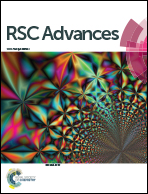Fabrication of local micro-contacts to silicon solar cells by dewetting of ultrathin polymer films†
Abstract
A local contact patterning process based on dewetting of 50 nm-thick polystyrene (PS) films has been developed for fabrication of silicon PERC (Passivated Emitter and Rear Cell) solar cells. Holey PS films with a random pattern of holes were prepared on dielectric passivated silicon wafers through the dewetting process, and then served as etch masks for selective plasma etching of dielectric passivation layers, in doing so metal contact patterns could be generated. The impact of local back contact formation on cell performance was studied as a function of the metallization fraction. This chemical-based patterning process, which broadens the applications of dewetting of polymer films, offers an interesting alternative to laser-based approaches as it may avoid silicon surface damage and lower the manufacturing costs. The application of this patterning technique to PERC fabrication could result in a preliminary efficiency of 13.5% with a Voc = 655 mV and a Jsc = 38.4 mA cm−2. An apparent gain in conversion efficiency of 0.6% could be achieved compared to the full-area aluminum back surface field reference cell.



 Please wait while we load your content...
Please wait while we load your content...